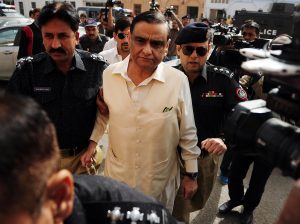Pakistan 2016: A Pandora’s Box
By Deneb Sumbul | Newsbeat National | Published 9 years ago
Criminal Negligence
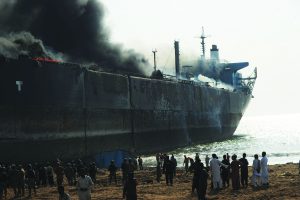 On the morning of November 1, a massive blast ripped apart a 22,000-ton oil tanker that was being broken up for scrap at the Gadani ship-breaking yard, about 50 kilometres northwest of Karachi. The explosion shook the entire yard, sent heavy pieces of metal flying up to 300 metres away, and set the vessel ablaze. Although there is no concrete evidence to determine the number, it is believed up to 100 workers died in the explosion and the fire that ensued, and at least 58 injured were brought to the Civil Hospital burns unit from Gadani. There were conflicting reports as to what triggered the blaze, but the oil tanker was said to be full of combustible residue fuel, chemicals and fumes.
On the morning of November 1, a massive blast ripped apart a 22,000-ton oil tanker that was being broken up for scrap at the Gadani ship-breaking yard, about 50 kilometres northwest of Karachi. The explosion shook the entire yard, sent heavy pieces of metal flying up to 300 metres away, and set the vessel ablaze. Although there is no concrete evidence to determine the number, it is believed up to 100 workers died in the explosion and the fire that ensued, and at least 58 injured were brought to the Civil Hospital burns unit from Gadani. There were conflicting reports as to what triggered the blaze, but the oil tanker was said to be full of combustible residue fuel, chemicals and fumes.
Skyfall
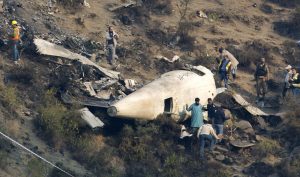 On December 7, Pakistan International Airlines flight ATR-42 from Chitral to Islamabad, crashed into the mountains near Havelian — just a half hour’s distance from Islamabad airport — killing all 37 passengers and crew members aboard, including the popular pop-star turned evangelist, Junaid Jamshed. The preliminary Civil Aviation Authority report stated that one of the ill-fated aircraft’s engines had malfunctioned and exploded. The ensuing fire charred bodies beyond recognition. Following the crash PIA retired all the ATR 42s in its fleet, but then PIA officials were seen slaughtering a black goat at the airport to celebrate the reinduction of at least one of the planes for Northern Area flights.
On December 7, Pakistan International Airlines flight ATR-42 from Chitral to Islamabad, crashed into the mountains near Havelian — just a half hour’s distance from Islamabad airport — killing all 37 passengers and crew members aboard, including the popular pop-star turned evangelist, Junaid Jamshed. The preliminary Civil Aviation Authority report stated that one of the ill-fated aircraft’s engines had malfunctioned and exploded. The ensuing fire charred bodies beyond recognition. Following the crash PIA retired all the ATR 42s in its fleet, but then PIA officials were seen slaughtering a black goat at the airport to celebrate the reinduction of at least one of the planes for Northern Area flights.
Terror Diaries
Punjab
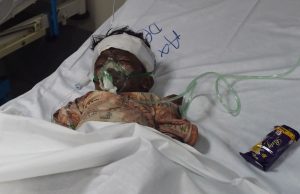 On March 27, a bomber blew himself up at the entrance of Lahore’s Gulshan-e-Iqbal Amusement Park, wreaking carnage on crowds of Christian families — and people of other faiths — that were enjoying Easter Sunday at the park. The explosion was heard several kilometres away, leaving over 70, including children, dead, and at least 300 injured.
On March 27, a bomber blew himself up at the entrance of Lahore’s Gulshan-e-Iqbal Amusement Park, wreaking carnage on crowds of Christian families — and people of other faiths — that were enjoying Easter Sunday at the park. The explosion was heard several kilometres away, leaving over 70, including children, dead, and at least 300 injured.
The blast was said to be the bloodiest attack on Pakistani Christians since the 2013 church bombing in Peshawar that killed more than 80 people. The spokesperson of the Taliban splinter group, Jamaat-ul-Ahrar, claimed responsibility, saying they had specifically targeted Christians.
Many believe the attack had a wider context, as an alliance of more than 30 religious groups had set March 27 as the deadline for the Punjab provincial government to withdraw a new women’s rights law they opposed. Thousands of members of these groups occupied a high-security zone in Islamabad to press their demands, which included the implementation of Shariah law. Interestingly supporters of Mumtaz Qadri, the police guard executed the previous month for the 2011 killing of the Punjab governor, Salman Taseer, had brought forward by 13 days the customary 40th day mourning rituals for Qadri, it is believed to coincide with March 27.
After the attack on the Christian community in Lahore the Punjab government came under pressure to begin visible operations against militant and criminal elements.
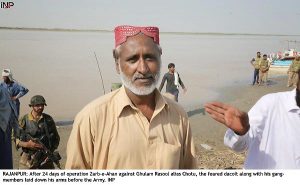 In early April, the Punjab police and the paramilitary Rangers launched an operation against the ‘Chottu’ gang in Rajanpur, prematurely, it is said, to pre-empt military involvement. They paid a heavy price for the lack of planning. Bogged down in the riverine area, the bandits who had fled into the nearby forests consistently targeted them. On April 13, 10 policemen were killed and 25 were taken hostage. The army stepped in, taking over the operation in Punjab and demanding surrender from the bandits. On April 20, Ghulam Rasool alias ‘Chottu,’ and his bandit gang laid down their arms and gave themselves up.
In early April, the Punjab police and the paramilitary Rangers launched an operation against the ‘Chottu’ gang in Rajanpur, prematurely, it is said, to pre-empt military involvement. They paid a heavy price for the lack of planning. Bogged down in the riverine area, the bandits who had fled into the nearby forests consistently targeted them. On April 13, 10 policemen were killed and 25 were taken hostage. The army stepped in, taking over the operation in Punjab and demanding surrender from the bandits. On April 20, Ghulam Rasool alias ‘Chottu,’ and his bandit gang laid down their arms and gave themselves up.
On December 30, a suicide bomber tried to target members of the Counter-Terrorism Department who were praying at a mosque close to their office in Rahim Yar Khan. Two people were injured in the attack, with the only fatality being the suicide bomber.
Balochistan
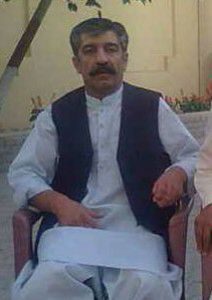 On the morning of August 8, while on his way to work, the 46-year-old former president of the Balochistan Bar Association, Advocate Bilal Anwar Kasi was gunned down by unidentified gunmen near Quetta’s Mengal Chowk. As the legal fraternity gathered at the city’s Civil Hospital to receive his body, a powerful suicide bomb ripped through the facility, followed by gunfire — resulting in 70 fatalities and another 130 injured. Among the dead were 54 advocates — the cream of Quetta’s legal fraternity. Various Islamist groups, including Jamaat-ul-Ahrar and the Islamic State, claimed responsibility for the attack. The Pakistan Foreign Ministry accused the Indian and Afghan intelligence agencies of orchestrating the attack, while the ISPR stated that foreign intelligence agencies and local extremist groups had colluded in the attack to derail the China Pakistan Economic Corridor (CPEC).
On the morning of August 8, while on his way to work, the 46-year-old former president of the Balochistan Bar Association, Advocate Bilal Anwar Kasi was gunned down by unidentified gunmen near Quetta’s Mengal Chowk. As the legal fraternity gathered at the city’s Civil Hospital to receive his body, a powerful suicide bomb ripped through the facility, followed by gunfire — resulting in 70 fatalities and another 130 injured. Among the dead were 54 advocates — the cream of Quetta’s legal fraternity. Various Islamist groups, including Jamaat-ul-Ahrar and the Islamic State, claimed responsibility for the attack. The Pakistan Foreign Ministry accused the Indian and Afghan intelligence agencies of orchestrating the attack, while the ISPR stated that foreign intelligence agencies and local extremist groups had colluded in the attack to derail the China Pakistan Economic Corridor (CPEC).
Justice Qazi Faez Isa made public a detailed report on the tragedy called the Quetta Commission Report to which the Interior Minister Chaudhry Nisar Ali Khan reacted, by saying he would challenge it in the Supreme Court. The report also points to the failures in implementing the National Action Plan (NAP) and National Counter Terrorism Authority (NACTA).
The attack on the lawyers community was the most heinous, but not the only terrorist attack in Balochistan.
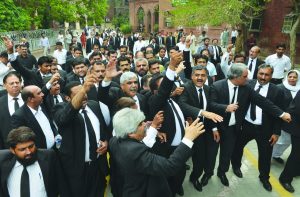
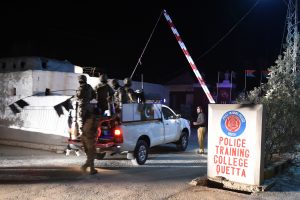 Fifteen people were killed and 25 injured after a bomb exploded near a polio centre in Quetta on January 13. Among the casualties, one civilian, a soldier and 13 policemen — ironically, who were the security detail provided for the polio workers in the area. Both, the Tehreek-e-Taliban and Jaish-ul-Islam claimed responsibility for this attack. On January 29 a suicide bomber who tried to enter the Zhob cantonment was stopped by guards. He blew himself up at the checkpost, injuring those around him. The Tehreek-e-Taliban Pakistan claimed responsibility for the attack. And in Quetta on February 6, the Tehreek-e-Taliban carried out another attack, which targeted a paramilitary Frontier Corps convoy, killing nine and injuring 35. On October 24, the Balochistan Police Training College in Quetta was targeted by terrorists. Both Islamic State (IS) and Jamaat-ul-Ahrar claimed responsibility for this attack. The three militants who attacked the campus took between 200 and 500 cadets hostage, and then two blew themselves up, killing 61 cadets and injuring over 190. The third terrorist was killed in the counter-assault that ensued.
Fifteen people were killed and 25 injured after a bomb exploded near a polio centre in Quetta on January 13. Among the casualties, one civilian, a soldier and 13 policemen — ironically, who were the security detail provided for the polio workers in the area. Both, the Tehreek-e-Taliban and Jaish-ul-Islam claimed responsibility for this attack. On January 29 a suicide bomber who tried to enter the Zhob cantonment was stopped by guards. He blew himself up at the checkpost, injuring those around him. The Tehreek-e-Taliban Pakistan claimed responsibility for the attack. And in Quetta on February 6, the Tehreek-e-Taliban carried out another attack, which targeted a paramilitary Frontier Corps convoy, killing nine and injuring 35. On October 24, the Balochistan Police Training College in Quetta was targeted by terrorists. Both Islamic State (IS) and Jamaat-ul-Ahrar claimed responsibility for this attack. The three militants who attacked the campus took between 200 and 500 cadets hostage, and then two blew themselves up, killing 61 cadets and injuring over 190. The third terrorist was killed in the counter-assault that ensued.
On November 12, at the shrine of Shah Noorani in Khuzdar, Balochistan, at least 52 people were killed and more than 100 injured when a suicide bomber blew himself up after Maghrib prayers. IS also claimed responsibility for this assault. And on November 26, unknown militants attacked the vehicle of an oil exploration company in Gwadar killing two of their guards.
Khyber Pakhtunkhwa
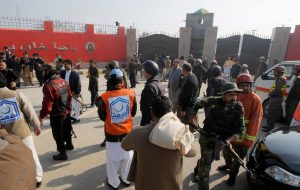 Khyber Pakhtunkhwa continued to be targeted by terrorist attacks by Tehreek-e-Taliban Pakistan factions throughout 2016. The year started out with the brutal attack on the Bacha Khan University in Charsadda on January 20, in which 22 people were killed and 20 injured. Charsadda was hit once again on March 7, when a suicide bomber struck the local court in revenge for the execution of Mumtaz Qadri. In March, a bomb went off in Peshawar, in a bus carrying government employees, killing 17 and injuring 53.
Khyber Pakhtunkhwa continued to be targeted by terrorist attacks by Tehreek-e-Taliban Pakistan factions throughout 2016. The year started out with the brutal attack on the Bacha Khan University in Charsadda on January 20, in which 22 people were killed and 20 injured. Charsadda was hit once again on March 7, when a suicide bomber struck the local court in revenge for the execution of Mumtaz Qadri. In March, a bomb went off in Peshawar, in a bus carrying government employees, killing 17 and injuring 53.
On April 19, at least one person was killed and 17 others wounded, after a suicide bomber attacked an excise and taxation office in Mardan, with the Jamaat-ul-Ahrar taking responsibility for this attack.
The next day a roadside bomb in Mohmand Agency of FATA — once again the handiwork of the Jamaat-ul-Ahrar — killed a member of a peace committee and his friend. The Jamaat-ul-Ahrar struck again in their campaign against the country’s judicial system on September 2 with a suicide blast at the Mardan district courts in Peshawar, killing 14 and wounding 52 people. For a while it seemed like the attacks had shifted to FATA when, on September 16, 23 people were killed and dozens more injured when a suicide bomber blew himself up at a mosque during Friday prayers in the Mohmand Agency. On November 26, two Frontiers Corps personnel were killed and 14 others injured when four suicide bombers attacked a camp in Mohmand Agency. Jamaat-ul-Ahrar claimed responsibility.
Attacks also continued in Peshawar as a counter-terrorism officer was killed in an ambush by militants on December 10. The provincial and federal governments’ response to this litany of terror? Stock commiserations, the occasional monetary compensations to relatives of those lost, or the desultory debate about integrating FATA with Khyber Pakhtunkhwa.
Sindh
Pakistan saw politically motivated arrests and inexplicable releases from detention in 2016. Most of these occurred in the first month of the year. To begin with, on January 18, Pervez Musharraf was acquitted for the murder of Nawab Akbar Bugti, the Baloch tribal leader who died in a military operation in 2006. The former military dictator left the country soon after.
Then on January 30, People’s Aman Committee leader, Uzair Jan Baloch was arrested. He remains in prison.
Dr Asim Hussain, a close associate of former President Asif Ali Zardari meanwhile, remains in detention, while charges of corruption against him continue to be investigated.
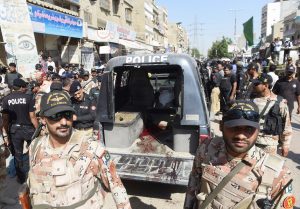 According to his supporters, his health has deteriorated so badly while in confinement that he has had to be hospitalised in the Jinnah Post Graduate Medical centre.
According to his supporters, his health has deteriorated so badly while in confinement that he has had to be hospitalised in the Jinnah Post Graduate Medical centre.
In Sindh, terrorist attacks appeared to be limited to Karachi and Shikarpur. On April 20, seven policemen guarding a polio team were killed in Karachi’s Orangi township in an attack by militants of the Lashkar-e-Jhangvi. May 7 in Karachi saw the murder of anti-sectarianism activist, Khurram Zaki, by unknown assassins. The last major attack in Karachi by terrorists took place on June 22, when famed Qawwal, Amjad Sabri was killed by a cell of assassins from Lashkar-e-Jhangvi’s Naeem Bukhari group.
On September 13, two suicide bombers tried to attack an Imambargah in Shikarpur on Eid, but their intentions were thwarted. However, 13 bystanders suffered injuries when one of the assailants blew himself up, while the other bomber was captured.
Caught in the Crossfire
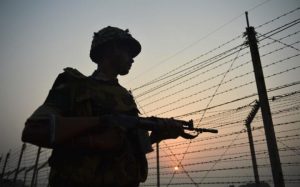 Failing to quell the indigenous uprising in Kashmir, India resorted to cross-border firing to deflect the world’s attention from the brutal state response to the movement. Indian forces repeatedly targeted Pakistani civilians, all the while blaming Pakistan for border violations.
Failing to quell the indigenous uprising in Kashmir, India resorted to cross-border firing to deflect the world’s attention from the brutal state response to the movement. Indian forces repeatedly targeted Pakistani civilians, all the while blaming Pakistan for border violations.
On October 24, a civilian in the village of Janglora and an 18-month old girl were killed by Indian fire. Intermittent incidents of fire from across the border continued in Harpal, Pukhlian and Charwah in the Sialkot district.
Pakistan announced that on October 28 and 29, six people were killed and 10 injured in the Nakyal and the adjacent Tatta Pani sectors of Azad Kashmir.
On November 8, Indian firing killed three civilians and wounded six others in the Khuiratta and Battal sectors of Azad Kashmir. The dead included a 10-year-old girl, and her mother as well as a civilian who died on the way to the hospital.
On November 24, nine civilians were killed and nine injured in the Dudhnial sector of Azad Kashmir when Indian shelling struck a bus. Then on December 16, a Pakistani school bus driver was killed and eight of the children he was transporting injured when Indian firing hit his school bus, again in the Nakyal sector.
Taliban’s Generation Next
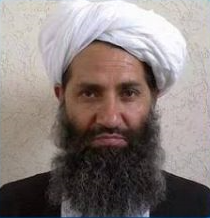 Mullah Mansour Akhtar, the de-facto leader of the Afghan Taliban, was killed in Balochistan’s Noshki district in Pakistan by a US drone strike on May 21, while he was travelling from Iran to Quetta. This was the first US drone strike in Pakistan outside the Federally Administered Tribal Areas, and the first in Balochistan. On May 25, Hibatullah Akhundzada took over from the murdered Mullah Mansour Akhtar as the new head of the Afghan Taliban.
Mullah Mansour Akhtar, the de-facto leader of the Afghan Taliban, was killed in Balochistan’s Noshki district in Pakistan by a US drone strike on May 21, while he was travelling from Iran to Quetta. This was the first US drone strike in Pakistan outside the Federally Administered Tribal Areas, and the first in Balochistan. On May 25, Hibatullah Akhundzada took over from the murdered Mullah Mansour Akhtar as the new head of the Afghan Taliban.
The Kite Still Flies
 Altaf Hussain’s vicious tirade against Pakistan (“Pakistan is a cancer… a headache… The epicentre of terrorism for the whole world…down with Pakistan”) on August 22, set off a chain of events that engendered what no one could have imagined a year ago: he faced estrangement from the party of which he had, until then, been the ultimate supremo. After his speech, and at his instigation, MQM members went on the rampage, creating a political firestorm. Resultantly, condemnations of the MQM and its leaders rolled in, placing the MQM’s top brass in Pakistan on the horns of a dilemma: either be tarred as traitors to Pakistan, or join the chorus of condemnation of their leader.
Altaf Hussain’s vicious tirade against Pakistan (“Pakistan is a cancer… a headache… The epicentre of terrorism for the whole world…down with Pakistan”) on August 22, set off a chain of events that engendered what no one could have imagined a year ago: he faced estrangement from the party of which he had, until then, been the ultimate supremo. After his speech, and at his instigation, MQM members went on the rampage, creating a political firestorm. Resultantly, condemnations of the MQM and its leaders rolled in, placing the MQM’s top brass in Pakistan on the horns of a dilemma: either be tarred as traitors to Pakistan, or join the chorus of condemnation of their leader.
Most of them took the latter option — perhaps recognising that therein lay their political survival. One after the other, senior MQM leaders across the assemblies distanced themselves from Altaf Hussain and his remarks, and declared themselves the MQM-Pakistan, with Farooq Sattar at the helm. The London-based Altaf Hussain controlled-network was, meanwhile, dubbed the MQM-London or MQM-Altaf.
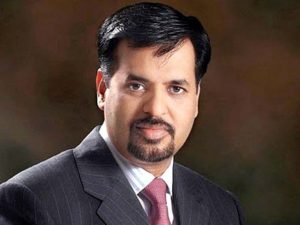 This added to the divisions in the Muttahida’s votebank, which had, in March, already seen the birth of
This added to the divisions in the Muttahida’s votebank, which had, in March, already seen the birth of 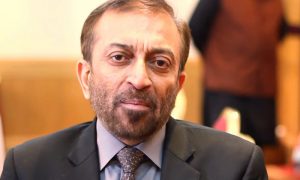 the Pak Sarzameen Party, formed by former MQM mayor of Karachi, Syed Mustafa Kamal, and a few others.
the Pak Sarzameen Party, formed by former MQM mayor of Karachi, Syed Mustafa Kamal, and a few others.
So now, come elections, the Mohajir community will have three parties to look to: the Farooq Sattar led MQM-Pakistan, Altaf Hussain’s MQM network in Karachi, and the Pak Sarzameen Party.
Back From Oblivion
Ali Haider Gilani
 On 11 May, 2016, almost three years to the day, Ali Haider Gilani, the son of ex-Prime Minister Yousuf Raza Giliani, who was abducted from Multan while canvassing for votes for a provincial assembly seat, was recovered from Afghanistan in a joint operation by Afghan and US forces called ‘Operation Freedom’s Sentinel.’ Haider had been found captive in a compound occupied by Al Qaeda operatives in the Gaylan district. He was flown back to Pakistan in a special aircraft.
On 11 May, 2016, almost three years to the day, Ali Haider Gilani, the son of ex-Prime Minister Yousuf Raza Giliani, who was abducted from Multan while canvassing for votes for a provincial assembly seat, was recovered from Afghanistan in a joint operation by Afghan and US forces called ‘Operation Freedom’s Sentinel.’ Haider had been found captive in a compound occupied by Al Qaeda operatives in the Gaylan district. He was flown back to Pakistan in a special aircraft.
Shahbaz Taseer,
Shahbaz Taseer, the abducted son of the assassinated former Governor of Punjab, Salman Taseer, was recovered from Kuchlak, Balochistan on March 8, 2016, after four-and-a half years in captivity. He had been seized in August 2011 by gunmen while driving to work from his residence in Lahore, only a few months after his father was gunned down by his security guard, Mumtaz Qadri, for opposing Pakistan’s blasphemy laws.
According to Taseer, he had been kidnapped by Uzbek militants and brutally tortured, and then taken prisoner by the Afghan Taliban, a senior member of which later released him. Several aspects of Shahbaz Taseer’s release/recovery are still unclear, but his freedom came barely a week after the hanging of Mumtaz Qadri.
Abdul Wahid Baloch
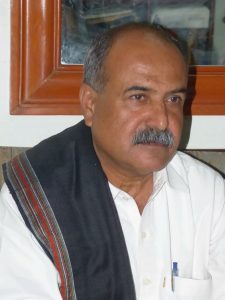 On December 5, 2016, political activist Abdul Wahid Baloch reappeared at his home in Chakiwara, Karachi, after having gone missing since July 26. Baloch had been picked up from the Super Highway Toll Plaza by unidentified men while on his return with a friend from an event in interior Sindh, and had been unheard of since then. Members of civil society, particularly the Human Rights Commission of Pakistan, (HRCP), kept the matter of his mysterious disappearance alive by holding demonstrations and pressurising the concerned authorities to provide some answers. At the HRCP’s insistence, the police had registered an FIR about Baloch’s disappearance in September. Before the case could be heard, the 52-year-old Civil Hospital telephone operator reappeared, just as mysteriously as he had disappeared.
On December 5, 2016, political activist Abdul Wahid Baloch reappeared at his home in Chakiwara, Karachi, after having gone missing since July 26. Baloch had been picked up from the Super Highway Toll Plaza by unidentified men while on his return with a friend from an event in interior Sindh, and had been unheard of since then. Members of civil society, particularly the Human Rights Commission of Pakistan, (HRCP), kept the matter of his mysterious disappearance alive by holding demonstrations and pressurising the concerned authorities to provide some answers. At the HRCP’s insistence, the police had registered an FIR about Baloch’s disappearance in September. Before the case could be heard, the 52-year-old Civil Hospital telephone operator reappeared, just as mysteriously as he had disappeared.
Baloch became a test case for the recovery of missing persons as the HRCP had shared their findings about his case with the Senate Standing Committee on Human Rights, who suggested that the federal and provincial governments should both be involved in his recovery.
Host With the Most
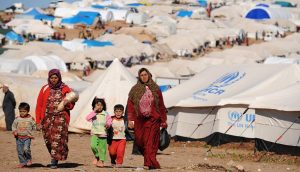 According to the UNHCR, amid fears of a crackdown on refugees by the Pakistan government, over 380,000 Afghans returned to their homeland in 2016. The sudden surge began after the doubling of the cash grant — to 400 USD — by the UNHCR in July for those returning voluntarily.
According to the UNHCR, amid fears of a crackdown on refugees by the Pakistan government, over 380,000 Afghans returned to their homeland in 2016. The sudden surge began after the doubling of the cash grant — to 400 USD — by the UNHCR in July for those returning voluntarily.
However, Pakistan still remains one of the largest refugee-hosting nations in the world, with an estimated 1.34 million registered refugees in 2016, and another half-a-million unregistered ones still residing in the country.
Slivers of Progress
 Pakistan saw some forward movement in 2016 in the legal protection of Pakistani women. On January 24, the Punjab Assembly passed the long-awaited Protection of Women Against Violence Bill 2015 in the face of vicious verbal opposition from the clerical lobby inside and outside government. Then on October 7, Pakistan’s National Assembly passed a strong bill against honour killing and rape. The bill ensured punishment for rapists and did away with loopholes that had allowed those who had committed or abetted so-called “honour” killings against women, to have gone free in the past.
Pakistan saw some forward movement in 2016 in the legal protection of Pakistani women. On January 24, the Punjab Assembly passed the long-awaited Protection of Women Against Violence Bill 2015 in the face of vicious verbal opposition from the clerical lobby inside and outside government. Then on October 7, Pakistan’s National Assembly passed a strong bill against honour killing and rape. The bill ensured punishment for rapists and did away with loopholes that had allowed those who had committed or abetted so-called “honour” killings against women, to have gone free in the past.
Change of Guard
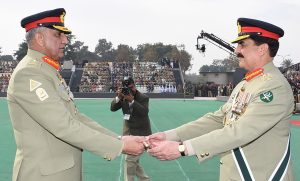 After months of media speculation and negative propaganda by extremist religious groups, the Prime Minister appointed General Qamar Javed Bajwa as the new Chief of Army Staff (COAS) on November 29. He will have to fill the very big boots of the highly popular General Raheel Sharif, but General Bajwa set the tone by visiting Peshawar and North Waziristan on his first day in office. General Raheel became the first army chief in the last two decades to retire from his office on schedule.
After months of media speculation and negative propaganda by extremist religious groups, the Prime Minister appointed General Qamar Javed Bajwa as the new Chief of Army Staff (COAS) on November 29. He will have to fill the very big boots of the highly popular General Raheel Sharif, but General Bajwa set the tone by visiting Peshawar and North Waziristan on his first day in office. General Raheel became the first army chief in the last two decades to retire from his office on schedule.
Education in Limbo
 At the behest of Turkish President Recep Tayyip Erdogan, the PakTurk Education Foundation — a private school chain operating in Pakistan since 1995, running a network of 28 schools and colleges across the country with around 11,000 students enrolled — was asked to close down by Pakistan’s federal government. The foundation was said to be administered by US-based Turkish cleric, Fethullah Gulen. President Erdogan’s former ally, whom he holds responsible for attempting to overthrow his government in July in a botched coup in Turkey.
At the behest of Turkish President Recep Tayyip Erdogan, the PakTurk Education Foundation — a private school chain operating in Pakistan since 1995, running a network of 28 schools and colleges across the country with around 11,000 students enrolled — was asked to close down by Pakistan’s federal government. The foundation was said to be administered by US-based Turkish cleric, Fethullah Gulen. President Erdogan’s former ally, whom he holds responsible for attempting to overthrow his government in July in a botched coup in Turkey.
However, in a new twist, on December 3, in response to two petitions appealing against the federal government’s decision to close the school chain filed by PakTurk schools’ teachers and by the parents of the students, the Sindh High Court struck down the federal government decree to deport the Turkish staff.
Many Turkish teachers, had however, already returned home. Some remain and the matter is still unresolved.
The writer is working with the Newsline as Assistant Editor, she is a documentary filmmaker and activist.



